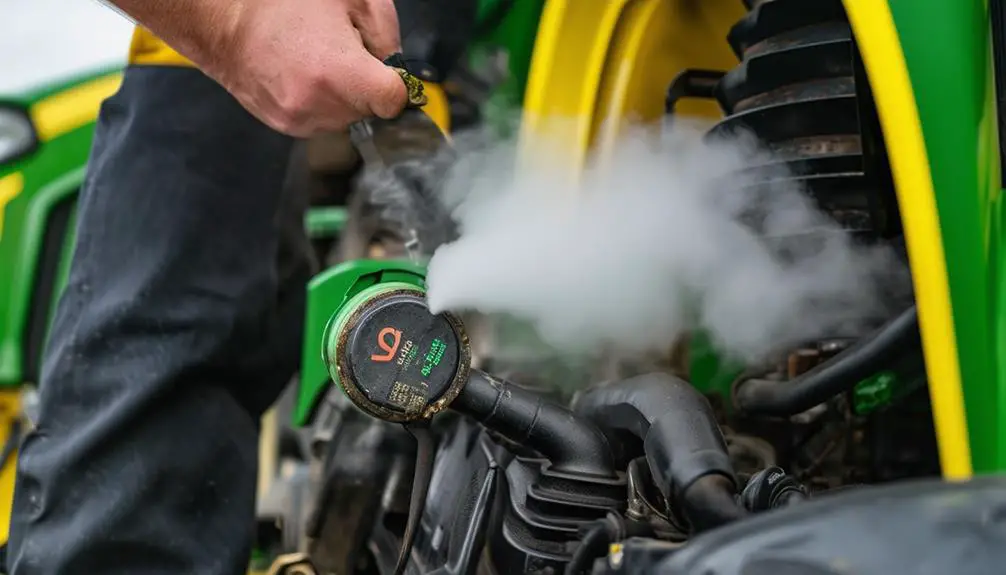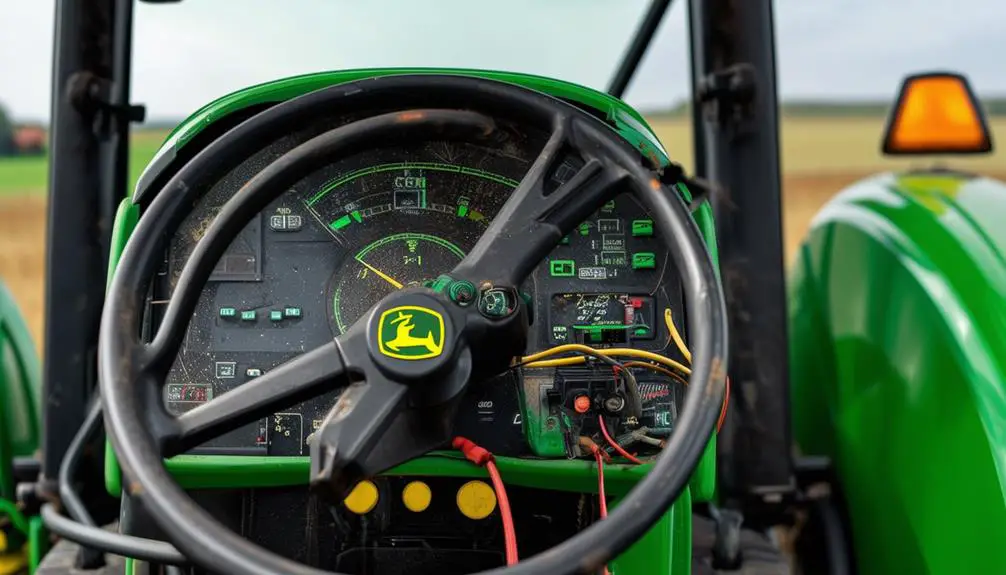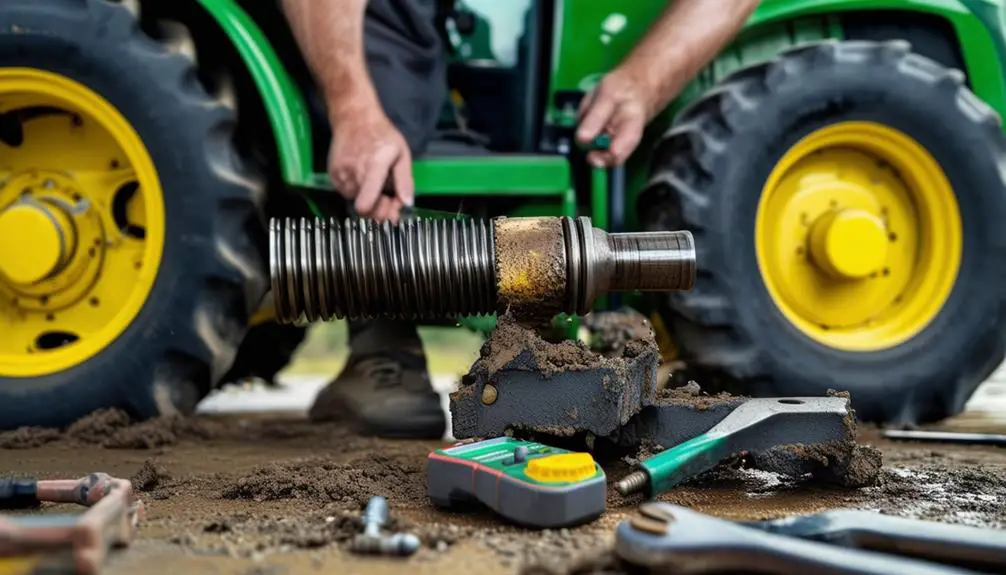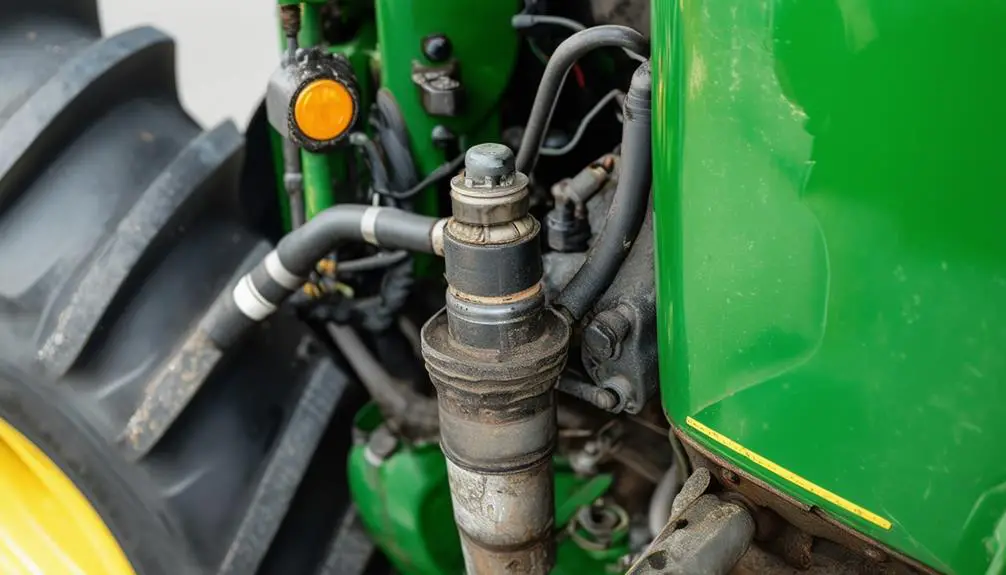If you've been encountering some challenges with your John Deere 3032e, you might be interested in learning about seven common issues that can occasionally arise. From engine temperature concerns to potential steering troubles, being aware of these common problems can help you keep your equipment in top shape. Stay tuned for valuable insights on how to address and prevent these issues effectively, ensuring your John Deere 3032e continues to perform at its best.
Things to Note
- Engine overheating due to coolant issues or radiator problems.
- Transmission troubles like gear shifting or clutch engagement issues.
- Electrical system concerns with battery drain or faulty wiring.
- Hydraulic system leaks from cracked hoses or worn seals.
- PTO malfunctions impacting power transfer; check for shaft damage or wiring issues.
Engine Overheating

If your John Deere 3032e is experiencing engine overheating, check the coolant levels and inspect for any leaks. Maintaining proper coolant levels is essential for your tractor's engine to function at its best. Low coolant levels can lead to overheating, causing damage to the engine components. Make sure that there are no leaks in the coolant system that could be leading to a loss of fluids. Regularly inspect hoses, connections, and the radiator for any signs of leakage.
In addition to checking coolant levels and leaks, make sure the radiator is clean and free from debris. A dirty radiator can hinder proper airflow, leading to overheating issues. Clean the radiator fins and remove any obstructions that could be blocking the airflow.
Lastly, consider the ambient temperature and workload when operating your John Deere 3032e. Extreme heat or heavy loads can put additional strain on the engine, contributing to overheating. Adjust your operating conditions accordingly to prevent excessive heat buildup.
Transmission Issues
If you're experiencing transmission issues with your John Deere 3032e, you may notice:
- Gear shifting problems.
- Hydraulic system malfunctions.
- Clutch engagement troubles.
These issues can impact the overall performance of your tractor and may require professional attention to resolve.
Keep an eye out for any signs of trouble to address them promptly and keep your equipment running smoothly.
Gear Shifting Problems
Experiencing difficulties with gear shifting on your John Deere 3032e tractor can be frustrating and impact your overall productivity. When gear shifting problems arise, it can disrupt your workflow and hinder the efficiency of your tasks. Here are some common gear shifting issues that John Deere 3032e owners have encountered:
| Gear Shifting Problems | Potential Causes |
|---|---|
| Hard to shift gears | Worn out clutch |
| Gear slippage | Low transmission fluid |
| Grinding noise while shifting | Misaligned gear linkage |
| Unable to engage a specific gear | Damaged synchro gears |
| Gear lever feels loose | Loose gear shift cables |
Dealing with gear shifting problems can be frustrating, but identifying the root cause can help you resolve these issues effectively. By understanding the potential causes listed above, you can take steps to address the problem and get back to using your John Deere 3032e smoothly.
Hydraulic System Malfunctions
Dealing with hydraulic system malfunctions on your John Deere 3032e tractor, particularly in relation to transmission issues, can greatly impact the performance and functionality of your equipment.
When the hydraulic system fails, you might experience difficulties in shifting gears smoothly. This can lead to jerky movements, delays in gear engagement, or even the inability to shift gears at all. These transmission issues can hinder your productivity and make operating the tractor a frustrating experience.
It's essential to address hydraulic system malfunctions promptly to avoid further damage to the transmission components. Regular maintenance checks and timely repairs can help prevent these issues from escalating. Ignoring these problems could result in costly repairs and prolonged downtime.
Stay proactive in monitoring the hydraulic system of your John Deere 3032e to ensure smooth gear shifting and peak performance.
Clutch Engagement Troubles
You may notice erratic clutch engagement on your John Deere 3032e tractor, indicating potential transmission issues that require attention. When dealing with clutch engagement troubles, addressing the problem promptly is vital to prevent further damage to your tractor's transmission.
Here are a few signs that may indicate clutch engagement issues:
- Unusual Grinding Sounds: If you hear grinding noises when engaging the clutch, it could be a sign of worn-out clutch components.
- Difficulty Shifting Gears: Struggling to shift gears smoothly or experiencing gear slippage can point towards clutch problems.
- Delayed Engagement: A delay in clutch engagement where the tractor doesn't respond immediately when the clutch is engaged signals potential transmission issues that need to be resolved.
Ignoring these symptoms can lead to more significant problems down the line, so addressing clutch engagement troubles promptly is necessary to keep your John Deere 3032e running smoothly.
Electrical System Problems

You may encounter battery drain issues or faulty wiring connections with your John Deere 3032e. These electrical system problems can lead to starting issues and overall performance concerns.
It's crucial to address these issues promptly to guarantee your tractor operates smoothly.
Battery Drain Issues
One common issue experienced by owners of the John Deere 3032e tractor is battery drain, which can be attributed to electrical system problems. If you're facing this frustrating situation, here are some possible culprits causing the battery drain:
- Faulty Alternator: An alternator that's not functioning properly can fail to charge the battery, leading to constant drain.
- Parasitic Draw: This sneaky issue happens when there's an electrical component drawing power even when the tractor is off, slowly draining the battery over time.
- Corroded Connections: Corrosion on the battery terminals or other electrical connections can interfere with the charging process, causing the battery to drain prematurely.
To tackle battery drain issues, it's important to inspect these areas carefully. By identifying and resolving these common problems, you can make sure that your John Deere 3032e is always ready to perform when you need it most.
Faulty Wiring Connections
Faulty wiring connections in the electrical system of your John Deere 3032e tractor can lead to various operational issues and potential safety hazards. When the wiring connections aren't secure or are damaged, it can result in erratic behavior of the lights, difficulty starting the tractor, or even complete electrical failure.
These issues can't only be frustrating but also pose risks to your safety while operating the equipment. To address faulty wiring connections, start by visually inspecting the wiring harness for any visible signs of wear, corrosion, or loose connections. Tighten any loose connections and replace any damaged wires or connectors promptly to prevent further problems.
Regularly checking and maintaining the wiring connections in your John Deere 3032e can help guarantee smooth operations and reduce the chances of unexpected electrical failures that could disrupt your work or compromise your safety.
Hydraulic System Leaks
When dealing with hydraulic system leaks on a John Deere 3032e, it's important to identify the source promptly to prevent further damage.
Here are some key points to keep in mind:
- Inspect Hoses: Check all hydraulic hoses for cracks, wear, or loose fittings that could be causing the leak.
- Examine Seals: Look at the seals on hydraulic cylinders and connections for any signs of wear or damage that may be leading to the leakage.
- Check Fluid Levels: Verify that the hydraulic fluid levels are within the recommended range, as low levels can cause air to enter the system and result in leaks.
PTO Malfunctions

Inspecting the power take-off (PTO) system regularly is important to identifying and addressing any potential malfunctions on your John Deere 3032e. Your PTO is vital for transferring power from your tractor to attached implements like mowers or balers. When your PTO malfunctions, it can disrupt your work and cause frustration.
Common issues include PTO shaft failure, clutch problems, or electrical faults. If you notice unusual noises, vibrations, or the PTO not engaging/disengaging properly, it's time to investigate further.
To diagnose PTO malfunctions, start by checking for any visible damage to the PTO shaft or surrounding components. Ensure all connections are secure and inspect the wiring for any signs of wear or fraying. Testing the PTO engagement and disengagement functions is also important.
If you encounter persistent issues, seek professional help to prevent further damage and guarantee your equipment operates smoothly. Remember, a proactive approach to PTO maintenance can save you time and money in the long run.
Steering Troubles
To address steering troubles on your John Deere 3032e, regularly check for any signs of abnormal steering response or difficulty in steering.
If you encounter steering issues, consider the following:
- Inspect the Steering Linkage: Look for any loose or damaged components in the steering linkage that may be affecting the responsiveness of your steering.
- Check the Power Steering Fluid: Verify that the power steering fluid is at the correct level and is free of any contaminants that could be hindering the smooth operation of the steering system.
- Examine the Steering Wheel: Evaluate the condition of the steering wheel for any wear or tear that could be impacting your ability to steer comfortably.
Fuel System Failures

Regularly monitor your John Deere 3032e for signs of fuel system failures to maximize performance and prevent potential issues. Fuel system failures can manifest in various ways, such as engine stalling, rough idling, decreased power output, or difficulty starting your tractor. If you notice any of these symptoms, it's essential to address them promptly to avoid more severe damage to your equipment.
Common causes of fuel system failures in the John Deere 3032e include contaminated fuel, clogged fuel filters, malfunctioning fuel injectors, or fuel pump issues. To prevent these problems, make sure you're using clean fuel and regularly replace fuel filters according to the manufacturer's recommendations.
Additionally, consider having a professional inspect and maintain your fuel system regularly to catch any potential issues early on.
Frequently Asked Questions
Can I Use Aftermarket Parts to Fix John Deere 3032E Problems?
Yes, you can use aftermarket parts to address John Deere 3032e problems. They provide cost-effective solutions that work just as effectively as original parts.
Make sure to research and select reputable aftermarket suppliers to guarantee quality and compatibility.
How Often Should I Service My John Deere 3032e?
When it comes to servicing your John Deere 3032e, it's important to stay on top of maintenance tasks. Regular servicing guarantees your machine keeps running smoothly.
Symbolizing dedication to care for your equipment, aim to service it every 100 hours of operation.
What Are the Most Common Maintenance Mistakes to Avoid?
To avoid common maintenance mistakes, make sure to follow the manufacturer's guidelines for servicing your John Deere 3032e regularly. Skipping routine maintenance can lead to costly repairs down the road.
Keep an eye on fluid levels, replace filters as recommended, and check for any signs of wear and tear. By staying on top of maintenance tasks, you can help prevent potential issues and keep your equipment running smoothly.
Are There Any Software Updates Available for the 3032e?
Yes, there are software updates available for the 3032e. Make sure to regularly check for any new updates to keep your equipment running smoothly.
Updating the software can often improve performance and address any potential issues. Stay proactive and keep your machine up to date to avoid any unnecessary problems down the line.
How Can I Prevent Future Issues With My John Deere 3032e?
To steer clear of future troubles with your John Deere 3032e, stay on top of regular maintenance like oil changes and filter replacements.
A stitch in time saves nine, so address any small issues promptly before they snowball into bigger problems.
Keep an eye on your machine's performance and listen for any unusual sounds, as early detection can prevent costly repairs down the road.
Conclusion
To sum up, staying on top of maintenance and addressing issues promptly can help you steer clear of common John Deere 3032e problems.
By keeping a watchful eye on your equipment's performance and seeking professional help when needed, you can avoid potential breakdowns and keep your machine running smoothly.
Remember, being proactive is the key to ensuring your John Deere 3032e stays in top shape, like a well-oiled machine ready to tackle any task.